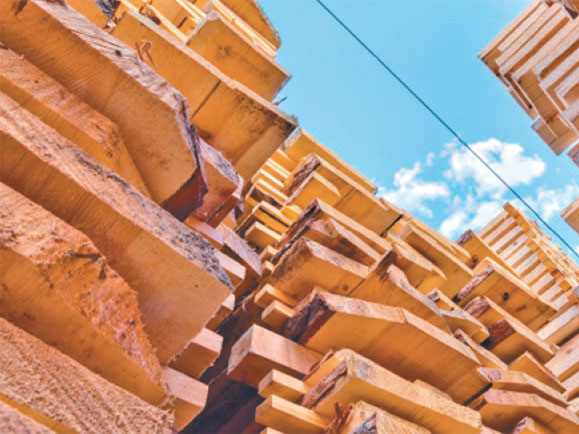In the past few decades, it seems, there has been one complex issue that simply refuses to disappear from the highly substantial commercial relationship between the United States and Canada. For more than 30 years, softwood lumber has been a festering bilateral trade irritant – with a series of breakdowns triggering U.S. tariffs followed by agreements that do not take long to expire. The twists and turns have been continuing, though arguably these days not to the advantage of the U.S. home buyer.
To briefly recapitulate the origins of this enduring dispute, it was launched in 1982, with the effects being affected especially in British Columbia, the leading Canadian exporter of softwood lumber to the United States.
At its core is the claim that the Canadian lumber industry is unfairly subsidized by federal and provincial governments, with most timber in Canada owned by the provincial authorities. The prices charged to harvest the timber (stumpage fees) are set administratively instead of through the competitive marketplace as is the practice in the United States. Softwood lumber lots in the U.S. are privately owned. The fees paid by Canadian lumber mills are lower than fees paid on U.S. timber.

Thus, U.S. industry interests argue that the Canadian system represents an unfair subsidy and is therefore subject to U.S. trade remedy laws in the form of countervailing duties to offset the subsidy.
The U.S. accounts for roughly two-thirds of Canada’s softwood lumber exports. And Canadian lumber imports are the largest supplier to the U.S. softwood lumber market.
In the latest measure, the Commerce Department last January pared back duties for some Canadian producers to under 10% while maintaining them in the 20% range for others.
But the Trudeau Canadian government reiterated its objections, and Foreign Minister Chrystia Freeland declared: “Canada has already begun legal challenges of these duties under NAFTA and through the WTO (World Trade Organization), where Canadian litigation has proven successful in the past.” She added the Ottawa government will “vigorously defend our industry and its workers against protectionist trade practices.”
Responded Commerce Secretary Wilbur Ross: “The Trump administration will continue to stand up against unfair trade practices that harm American workers and businesses.”
He has expressed confidence that the WTO in Geneva will eventually side with the U.S. on the current lumber issue. (The WTO this past April created two dispute settlement panels to examine Canada’s complaint about the lumber duties.)
During the prolonged NAFTA re-negotiations, the Trump administration has been pitching strongly for preserving the binding dispute-resolution mechanism that in the past has generally favored Canada in such trade conflicts as softwood lumber. Canadian negotiators regard this mechanism as an absolute must (or there is no deal).
In terms of the economic impact of the duties today for Canadian producers generally, significantly enough it has so far been relatively limited compared with similar duties in the past.
Indeed, according to Susan Yurkovich, president of the B.C. Lumber Council, higher prices and robust demand for new houses and renovation material in the United States have allowed Canadian producers to recoup the average 20% cost of the tariffs and to maintain market share. “Who’s really suffering is the U.S. consumer.”
Observers also note that more and more Canadian mills are striving to diversify their markets, reducing their reliance on the big U.S. market and moving into regions like Asia. Another factor, too, has been the steady weakening of the Canadian dollar, presently trading around 75 U.S. cents.
For its part, the National Home Builders Association (NAHB) recently complained that the tariffs on imported Canadian lumber are pricing some Americans out of the U.S. housing market, adding approximately $9,000 to the cost of single-family homes and as much as $3,000 to the average price of a multi-family unit.
Randy Noel, chairman of the NAHB, has encouraged Commerce Secretary Ross “to hammer out a long-term solution to this trade dispute that will ensure U.S. home builders have access to a stable supply of lumber at reasonable prices to keep housing affordable for hard-working American families.”
Canadian Shingle/Shake Makers Lose Tariff Exemption
Meanwhile, in a related development earlier this month (September), the U.S. Department of Commerce turned down a request from Canada’s shake and shingle industry to be exempt from the tariffs against Canadian softwood lumber.
In its ruling, the Commerce Department cited a passage from the U.S. Department of Agriculture’s Wood Handbook, which refers to production of shakes and shingles as being part of the lumber sector.
“This excerpt supports the proposition that there is no clear distinction between shake and shingle production and the lumber industry,” states the 20-page ruling from the Commerce Department’s anti-dumping and countervailing duty operations.
A recently-created Shake and Shingle Alliance had approached the Commerce Department last June to review the scope of the products falling under the softwood file. U.S. tariffs have been averaging over 20% against most Canadian lumber shipped south of the 49th Parallel.
Five of the Alliance members are based in British Columbia, the biggest player in Canada’s forestry industry. Four are in Quebec and three in New Brunswick. The Alliance is expected to soon appeal the Commerce Department decision.
The Canadian producers argue that cedar products are thin enough to warrant tariff exemptions and should not be confused with lumber. Cedar shakes and shingles (CSS) are used extensively for roofing, and also as siding.
However, in a notice last March, U.S. Customs and Protection indicated that cedar products tapered to less than six millimeters in thickness at one end are not necessarily exempt from the softwood lumber duties.
The Commerce Department concurred, noting: “CSS are not outside of the scope of the (tariff) orders simply because a portion of the product is tapered to less than six millimeters.”
This has been a tough blow to Canadian CSS producers who have been paying duties since March on their exports south of the border. Several producers shut down operations for several weeks in the summer as demand declined from U.S. customers.

Follow us on social media: